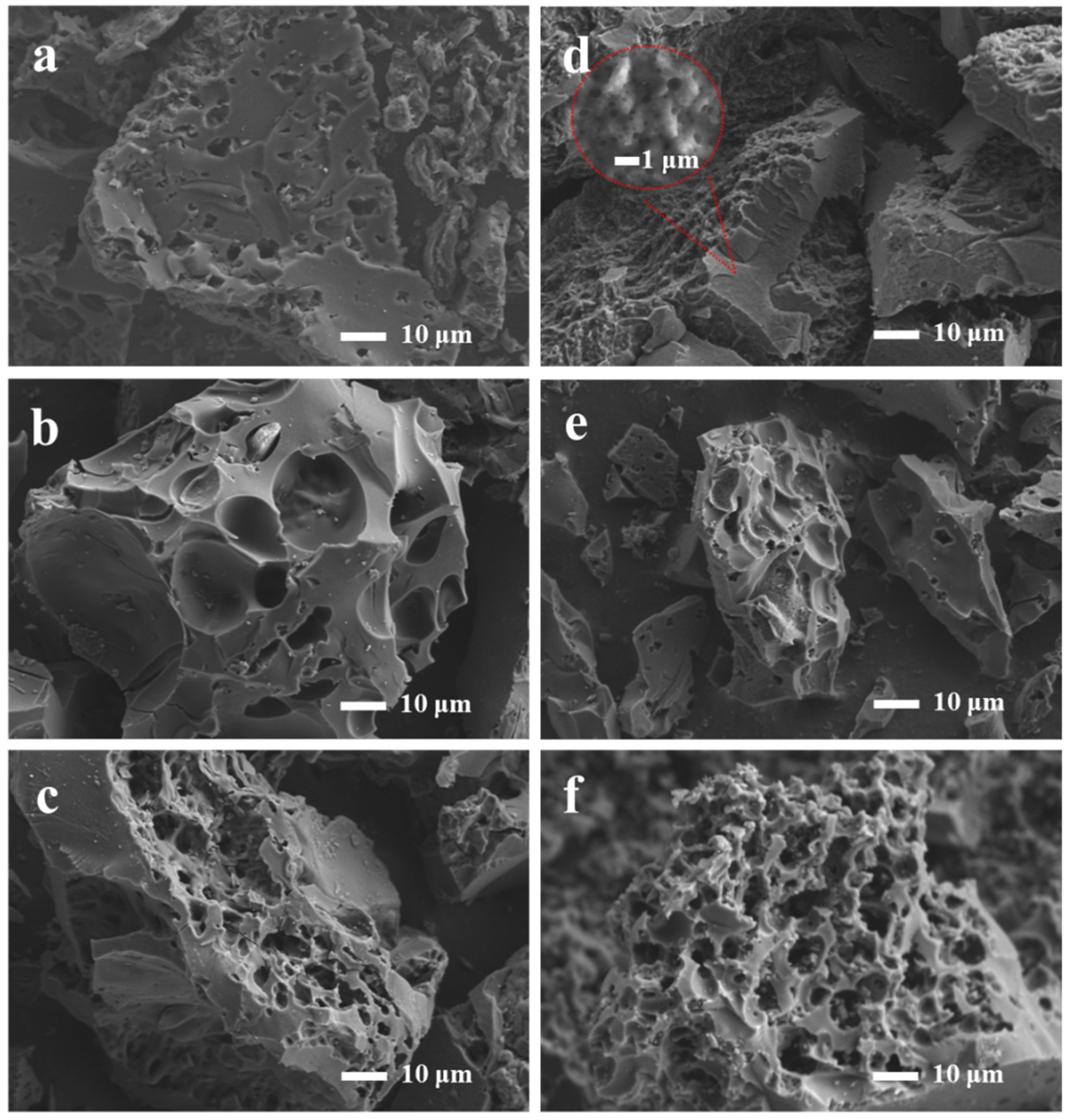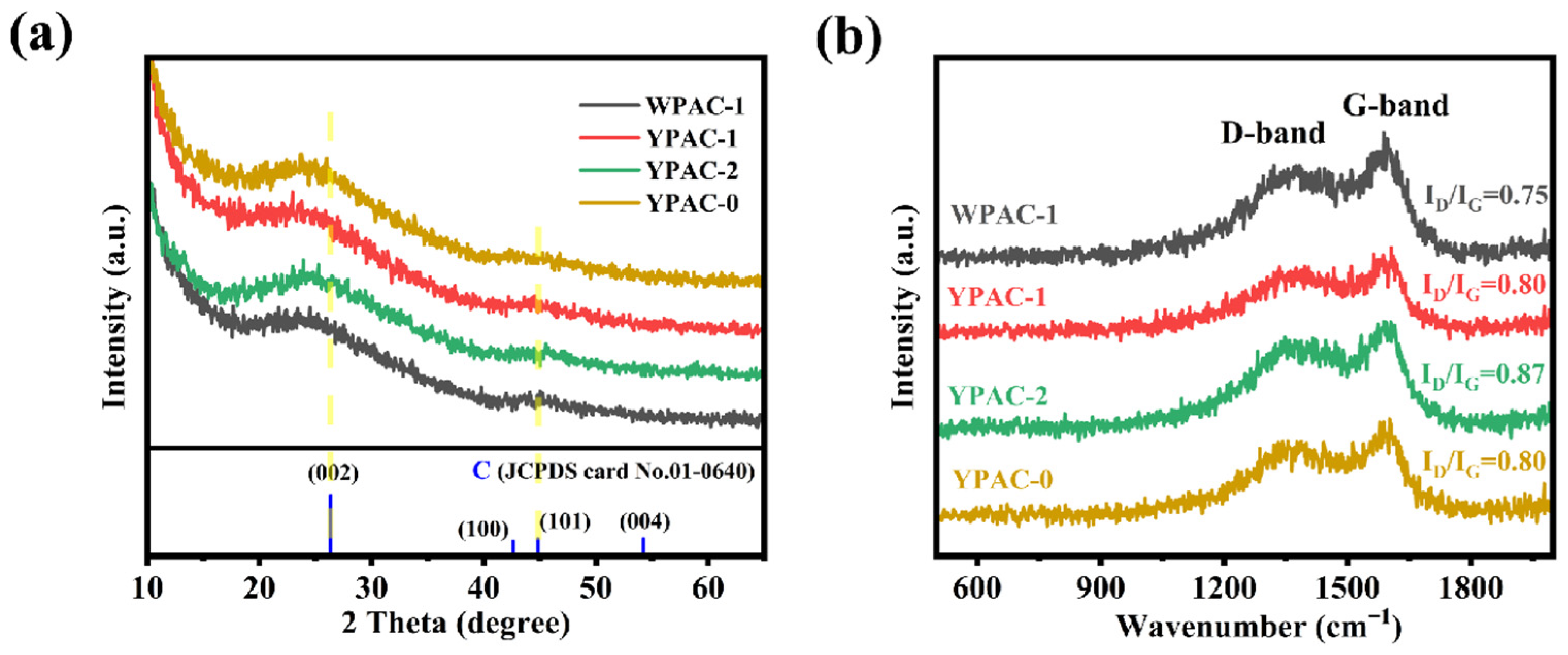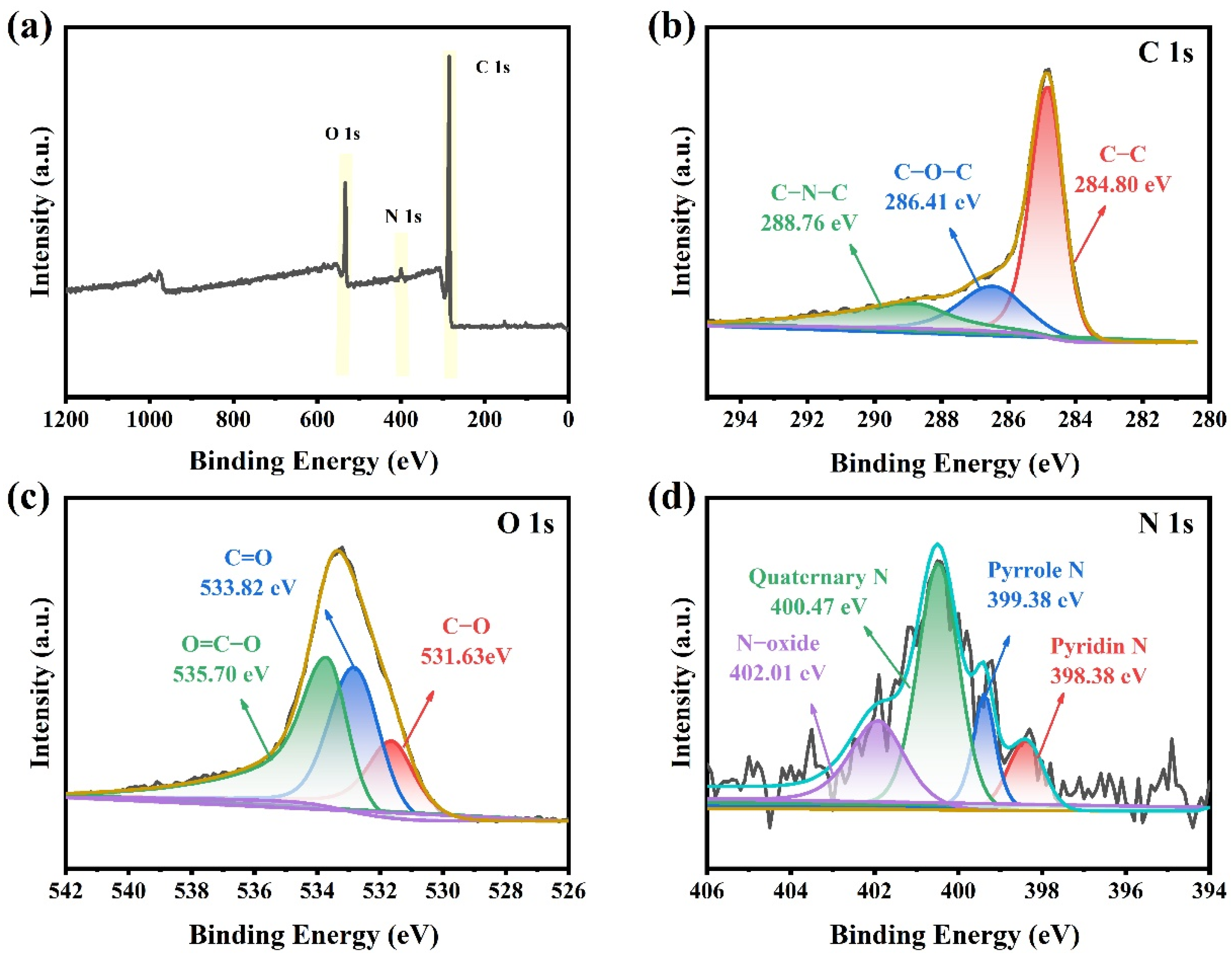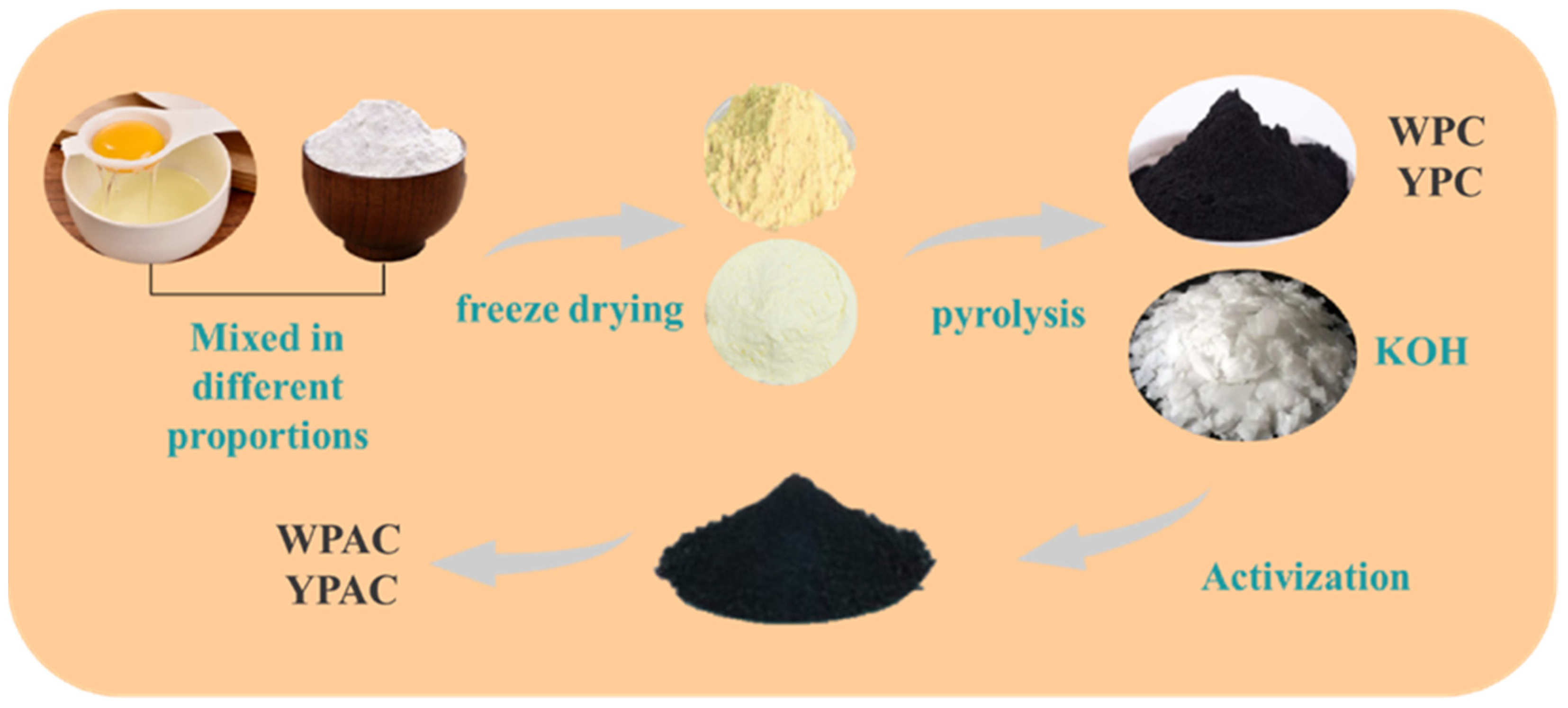In Situ N, O Co-Doped Nanoporous Carbon Derived from Mixed Egg and Rice Waste as Green Supercapacitor
Abstract
:1. Introduction
2. Results and Discussion
2.1. Morphology and Structure Analyses of N, O Co-Doped Porous Carbon
2.2. Chemical Composition Analysis of Porous Carbon
2.3. Electrochemical Performance
3. Materials and Methods
3.1. Materials and Chemicals
3.2. Synthesis of N, O Co-Doped Porous Carbon
3.3. Material Characterization
3.4. Electrochemical Measurements
4. Conclusions
Supplementary Materials
Author Contributions
Funding
Institutional Review Board Statement
Informed Consent Statement
Data Availability Statement
Acknowledgments
Conflicts of Interest
Sample Availability
References
- Lamba, P.; Singh, P.; Singh, P.; Singh, P.; Bharti; Kumar, A.; Gupta, M.; Kumar, Y. Recent advancements in supercapacitors based on different electrode materials: Classifications, synthesis methods and comparative performance. J. Energy Storage 2022, 48, 103871. [Google Scholar] [CrossRef]
- Sung, J.; Shin, C. Recent Studies on Supercapacitors with Next-Generation Structures. Micromachines 2020, 11, 1125. [Google Scholar] [CrossRef]
- Kumar, S.; Saeed, G.; Zhu, L.; Hui, K.N.; Kim, N.H.; Lee, J.H. 0D to 3D carbon-based networks combined with pseudocapacitive electrode material for high energy density supercapacitor: A review. Chem. Eng. J. 2021, 403, 126352. [Google Scholar] [CrossRef]
- Wu, F.; Gao, J.; Zhai, X.; Xie, M.; Sun, Y.; Kang, H.; Tian, Q.; Qiu, H. Hierarchical porous carbon microrods derived from albizia flowers for high performance supercapacitors. Carbon 2019, 147, 242–251. [Google Scholar] [CrossRef]
- Shang, Z.; An, X.; Zhang, H.; Shen, M.; Baker, F.; Liu, Y.; Liu, L.; Yang, J.; Cao, H.; Xu, Q.; et al. Houttuynia-derived nitrogen-doped hierarchically porous carbon for high-performance supercapacitor. Carbon 2020, 161, 62–70. [Google Scholar] [CrossRef]
- Naskar, P.; Maiti, A.; Chakraborty, P.; Kundu, D.; Biswas, B.; Banerjee, A. Chemical supercapacitors: A review focusing on metallic compounds and conducting polymers. J. Mater. Chem. A 2021, 9, 1970–2017. [Google Scholar] [CrossRef]
- Abdel Maksoud, M.I.A.; Fahim, R.A.; Shalan, A.E.; Abd Elkodous, M.; Olojede, S.O.; Osman, A.I.; Farrell, C.; Al-Muhtaseb, A.a.H.; Awed, A.S.; Ashour, A.H.; et al. Advanced materials and technologies for supercapacitors used in energy conversion and storage: A review. Environ. Chem. Lett. 2020, 19, 375–439. [Google Scholar] [CrossRef]
- Bi, Z.; Kong, Q.; Cao, Y.; Sun, G.; Su, F.; Wei, X.; Li, X.; Ahmad, A.; Xie, L.; Chen, C.M. Biomass-derived porous carbon materials with different dimensions for supercapacitor electrodes: A review. J. Mater. Chem. A 2019, 7, 16028–16045. [Google Scholar] [CrossRef]
- Fong, K.D.; Wang, T.; Smoukov, S.K. Multidimensional performance optimization of conducting polymer-based supercapacitor electrodes. Sustain. Energy Fuels 2017, 1, 1857–1874. [Google Scholar] [CrossRef]
- Meng, Q.; Cai, K.; Chen, Y.; Chen, L. Research progress on conducting polymer based supercapacitor electrode materials. Nano Energy 2017, 36, 268–285. [Google Scholar] [CrossRef]
- Niu, F.; Guo, R.; Dang, L.; Sun, J.; Li, Q.; He, X.; Liu, Z.; Lei, Z. Coral-like PEDOT Nanotube Arrays on Carbon Fibers as High-Rate Flexible Supercapacitor Electrodes. ACS Appl. Energy Mater. 2020, 3, 7794–7803. [Google Scholar] [CrossRef]
- Yang, S.; Cheng, Y.; Xiao, X.; Pang, H. Development and application of carbon fiber in batteries. Chem. Eng. J. 2020, 384, 123294. [Google Scholar] [CrossRef]
- Korkmaz, S.; Kariper, İ.A. Graphene and graphene oxide based aerogels: Synthesis, characteristics and supercapacitor applications. J. Energy Storage 2020, 27, 101038. [Google Scholar] [CrossRef]
- Zhao, C.; Guo, J.; Fan, J.; Zhang, X.; Zhao, C.; Chen, S. Surface engineering of reclaimed carbon fiber (RCF) electrode for superimposed supercapacitor performance. J. Energy Storage 2022, 46, 103786. [Google Scholar] [CrossRef]
- Saini, S.; Chand, P.; Joshi, A. Biomass derived carbon for supercapacitor applications: Review. J. Energy Storage 2021, 39, 102646. [Google Scholar] [CrossRef]
- Xu, B.; Zhang, H.; Mei, H.; Sun, D. Recent progress in metal-organic framework-based supercapacitor electrode materials. Coord. Chem. Rev. 2020, 420, 213438. [Google Scholar] [CrossRef]
- Gopalakrishnan, A.; Badhulika, S. Effect of self-doped heteroatoms on the performance of biomass-derived carbon for supercapacitor applications. J. Power Sources 2020, 480, 228830. [Google Scholar] [CrossRef]
- Han, S.W.; Bang, J.; Ko, S.H.; Ryoo, R. Variation of nitrogen species in zeolite-templated carbon by low-temperature carbonization of pyrrole and the effect on oxygen reduction activity. J. Mater. Chem. A 2019, 7, 8353–8360. [Google Scholar] [CrossRef]
- Zhang, Y.; Liu, L.; Zhang, P.; Wang, J.; Xu, M.; Deng, Q.; Zeng, Z.; Deng, S. Ultra-high surface area and nitrogen-rich porous carbons prepared by a low-temperature activation method with superior gas selective adsorption and outstanding supercapacitance performance. Chem. Eng. J. 2019, 355, 309–319. [Google Scholar] [CrossRef]
- Wang, L.; Luo, H.; Wang, C.; Yu, K.; Gong, L.; Wang, C.; Imran, M.; Zhou, B. Preparation and supercapacitor performance of melamine-modified 12-molybdophosphate and its N-doped carbon-coated copper and molybdenum carbide derivatives. J. Energy Storage 2022, 52, 104985. [Google Scholar] [CrossRef]
- Ran, F.; Yang, X.; Xu, X.; Li, S.; Liu, Y.; Shao, L. Green activation of sustainable resources to synthesize nitrogen-doped oxygen-riched porous carbon nanosheets towards high-performance supercapacitor. Chem. Eng. J. 2021, 412, 128673. [Google Scholar] [CrossRef]
- Li, Y.; Li, Z.; Xing, B.; Li, H.; Ma, Z.; Zhang, W.; Reubroycharoen, P.; Wang, S. Green conversion of bamboo chips into high-performance phenol adsorbent and supercapacitor electrodes by simultaneous activation and nitrogen doping. J. Anal. Appl. Pyrolysis 2021, 155, 105072. [Google Scholar] [CrossRef]
- Zhang, X.; Cai, W.; Zhao, S.; Li, X.; Jia, F.; Ma, F.; Yao, H. Discarded antibiotic mycelial residues derived nitrogen-doped porous carbon for electrochemical energy storage and simultaneous reduction of antibiotic resistance genes (ARGs). Environ. Res. 2021, 192, 110261. [Google Scholar] [CrossRef]
- Liu, P.; Qin, S.; Wang, J.; Zhang, S.; Tian, Y.; Zhang, F.; Liu, C.; Cao, L.; Zhou, Y.; Wang, L.; et al. Effective CO2 capture by in-situ nitrogen-doped nanoporous carbon derived from waste antibiotic fermentation residues. Environ. Pollut. 2023, 333, 121972. [Google Scholar] [CrossRef]
- Li, Z.; Xu, Z.W.; Tan, X.H.; Wang, H.L.; Holt, C.M.B.; Stephenson, T.; Olsen, B.C.; Mitlin, D. Mesoporous nitrogen-rich carbons derived from protein for ultra-high capacity battery anodes and supercapacitors. Energy Environ. Sci. 2013, 6, 871–878. [Google Scholar] [CrossRef]
- Hou, X.; Ren, P.; Dai, Z.; Chen, H.; Tang, W.; Chen, Z.; Ren, F.; Jin, Y. Ultrahigh voltage window, preeminent energy density aqueous supercapacitor derived from honeycomb-like porous carbon decorated with carbon dots. Electrochim. Acta 2022, 425, 140336. [Google Scholar] [CrossRef]
- Ma, L.; Cao, M.; Zhao, C.S.; Huang, S.; Ding, J.; Chen, J.; Zhou, Y. The novel N-rich hard carbon nanofiber as high-performance electrode materials for sodium-ion batteries. Ceram. Int. 2021, 47, 9118–9124. [Google Scholar] [CrossRef]
- Yang, W.; Chen, H.; Han, X.; Ding, S.; Shan, Y.; Liu, Y. Preparation of magnetic Co-Fe modified porous carbon from agricultural wastes by microwave and steam activation for mercury removal. J. Hazard. Mater. 2020, 381, 120981. [Google Scholar] [CrossRef]
- Guo, N.N.; Li, M.; Sun, X.K.; Wang, F.; Yang, R. Enzymatic hydrolysis lignin derived hierarchical porous carbon for supercapacitors in ionic liquids with high power and energy densities. Green Chem. 2017, 19, 2595–2602. [Google Scholar] [CrossRef]
- Tang, L.; Zhou, Y.B.; Zhou, X.Y.; Chai, Y.R.; Zheng, Q.J.; Lin, D.M. Enhancement in electrochemical performance of nitrogen-doped hierarchical porous carbon-based supercapacitor by optimizing activation temperature. J. Mater. Sci.-Mater. Electron. 2019, 30, 2600–2609. [Google Scholar] [CrossRef]
- Wang, S.; Miao, J.; Ren, B.; Xu, Y.; Tian, Z.; Zhang, L.; Liu, Z. Design of N-doped carbon materials using self-template strategy for high-performance supercapacitor electrodes and CO2 capture. J. Alloys Compd. 2022, 920, 165946. [Google Scholar] [CrossRef]
- Ma, C.; Bai, J.; Demir, M.; Hu, X.; Liu, S.; Wang, L. Water chestnut shell-derived N/S-doped porous carbons and their applications in CO2 adsorption and supercapacitor. Fuel 2022, 326, 125119. [Google Scholar] [CrossRef]
- Yu, Q.; Bai, J.; Huang, J.; Demir, M.; Farghaly, A.A.; Aghamohammadi, P.; Hu, X.; Wang, L. One-Pot Synthesis of Melamine Formaldehyde Resin-Derived N-Doped Porous Carbon for CO2 Capture Application. Molecules 2023, 28, 1772. [Google Scholar] [CrossRef]
- Cheng, S.; Wang, X.; Du, K.; Mao, Y.; Han, Y.; Li, L.; Liu, X.; Wen, G. Hierarchical Lotus-Seedpod-Derived Porous Activated Carbon Encapsulated with NiCo2S4 for a High-Performance All-Solid-State Asymmetric Supercapacitor. Molecules 2023, 28, 5020. [Google Scholar] [CrossRef] [PubMed]
- Chen, H.; Liu, T.; Mou, J.; Zhang, W.; Jiang, Z.; Liu, J.; Huang, J.; Liu, M. Free-standing N-self-doped carbon nanofiber aerogels for high-performance all-solid-state supercapacitors. Nano Energy 2019, 63, 032. [Google Scholar] [CrossRef]
- Sun, L.; Tian, C.G.; Li, M.T.; Meng, X.Y.; Wang, L.; Wang, R.H.; Yin, J.; Fu, H.G. From coconut shell to porous graphene-like nanosheets for high-power supercapacitors. J. Mater. Chem. A 2013, 1, 6462–6470. [Google Scholar] [CrossRef]
- Yu, Q.; Bai, J.; Huang, J.; Demir, M.; Altay, B.N.; Hu, X.; Wang, L. One-Pot Synthesis of N-Rich Porous Carbon for Efficient CO2 Adsorption Performance. Molecules 2022, 27, 6818. [Google Scholar] [CrossRef]
- Gao, C.X.; Duan, Y.T.; Liu, Y.; Gu, J.Y.; Guo, Z.Y.; Huo, P.F. A high energy density supercapacitor fabricated with aqueous polymer electrolyte based on soybean protein isolate grafted by polyacrylic acid. J. Power Sources 2022, 541, 231658. [Google Scholar] [CrossRef]
- Dai, S.; Liu, Z.; Zhao, B.; Zeng, J.; Hu, H.; Zhang, Q.; Chen, D.; Qu, C.; Dang, D.; Liu, M. A high-performance supercapacitor electrode based on N-doped porous graphene. J. Power Sources 2018, 387, 43–48. [Google Scholar] [CrossRef]
- Zhang, W.; Lin, H.; Lin, Z.; Yin, J.; Lu, H.; Liu, D.; Zhao, M. 3 D Hierarchical Porous Carbon for Supercapacitors Prepared from Lignin through a Facile Template-Free Method. ChemSusChem 2015, 8, 2114–2122. [Google Scholar] [CrossRef]
- Hu, J.; Hong, C.; Zhao, C.; Si, Y.; Xing, Y.; Ling, W.; Zhang, B.; Li, Z.; Wang, Y.; Feng, L.; et al. Nitrogen self-doped hierarchical porous carbon via penicillin fermentation residue (PR) hydrothermal carbonization (HTC) and activation for supercapacitance. J. Alloys Compd. 2022, 918, 165452. [Google Scholar] [CrossRef]
- Ma, H.Y.; Li, C.; Zhang, M.; Hong, J.D.; Shi, G.Q. Graphene oxide induced hydrothermal carbonization of egg proteins for high-performance supercapacitors. J. Mater. Chem. A 2017, 5, 17040–17047. [Google Scholar] [CrossRef]
- Liu, H.; Huang, X.; Zhou, M.; Gu, J.; Xu, M.; Jiang, L.; Zheng, M.; Li, S.; Miao, Z. Efficient conversion of biomass waste to N/O co-doped hierarchical porous carbon for high performance supercapacitors. J. Anal. Appl. Pyrolysis 2023, 169, 105844. [Google Scholar] [CrossRef]
- Rehman, A.U.; Afzal, A.M.; Iqbal, M.W.; Ali, M.; Wabaidur, S.M.; Al-Ammar, E.A.; Mumtaz, S.; Choi, E.H. Highly efficient and stable layered AgZnS@WS2 nanocomposite electrode as superior charge transfer and active redox sites for energy harvesting device. J. Energy Storage 2023, 71, 108022. [Google Scholar] [CrossRef]
- Peng, H.; Ma, G.; Sun, K.; Mu, J.; Zhang, Z.; Lei, Z. Facile Synthesis of Poly(p-phenylenediamine)-Derived Three-Dimensional Porous Nitrogen-Doped Carbon Networks for High Performance Supercapacitors. J. Phys. Chem. C 2014, 118, 29507–29516. [Google Scholar] [CrossRef]
- Qin, S.; Liu, P.; Wang, J.; Liu, C.; Wang, Q.; Chen, X.; Zhang, S.; Tian, Y.; Zhang, F.; Wang, L.; et al. In situ N, O co-doped porous carbon derived from antibiotic fermentation residues as electrode material for high-performance supercapacitors. RSC Adv. 2023, 13, 24140–24149. [Google Scholar] [CrossRef]
- Liu, W.J.; Tian, K.; Ling, L.L.; Yu, H.Q.; Jiang, H. Use of Nutrient Rich Hydrophytes to Create N, P-Dually Doped Porous Carbon with Robust Energy Storage Performance. Environ. Sci. Technol. 2016, 50, 12421–12428. [Google Scholar] [CrossRef]
- Song, M.; Zhou, Y.; Ren, X.; Wan, J.; Du, Y.; Wu, G.; Ma, F. Biowaste-based porous carbon for supercapacitor: The influence of preparation processes on structure and performance. J. Colloid Interface Sci. 2019, 535, 276–286. [Google Scholar] [CrossRef]
- Du, H.; Zhang, M.; Liu, K.; Parit, M.; Jiang, Z.; Zhang, X.; Li, B.; Si, C. Conductive PEDOT: PSS/cellulose nanofibril paper electrodes for flexible supercapacitors with superior areal capacitance and cycling stability. Chem. Eng. J. 2022, 428, 131994. [Google Scholar] [CrossRef]
- Kumar, T.R.; Senthil, R.A.; Pan, Z.; Pan, J.; Sun, Y. A tubular-like porous carbon derived from waste American poplar fruit as advanced electrode material for high-performance supercapacitor. J. Energy Storage 2020, 32, 101903. [Google Scholar] [CrossRef]
- Divya, P.; Rajalakshmi, R. Renewable low-cost green functional mesoporous electrodes from Solanum lycopersicum leaves for supercapacitors. J. Energy Storage 2020, 27, 101149. [Google Scholar] [CrossRef]
- Liu, P.; Xing, Z.; Wang, X.; Diao, S.; Duan, B.; Yang, C.; Shi, L. Nanoarchitectonics of nitrogen-doped porous carbon derived from leather wastes for solid-state supercapacitor. J. Mater. Sci. Mater. Electron. 2022, 33, 4887–4901. [Google Scholar] [CrossRef]








| Sample | SBET 1 | Smic 2 | Vmic 3 | Vt 4 | Vmic/Vt |
|---|---|---|---|---|---|
| (m2 g−1) | (m2 g−1) | (cm3 g−1) | (cm3 g−1) | (%) | |
| WPAC-1 | 1666.4 | 906.5 | 0.4081 | 0.8651 | 47.17% |
| WPAC-2 | 1414.8 | 831.3 | 0.3753 | 0.7342 | 51.12% |
| WPAC-0 | 1466.1 | 782.1 | 0.3521 | 0.7822 | 45.01% |
| YPAC-1 | 1572.1 | 978.9 | 0.4412 | 0.8164 | 54.04% |
| YPAC-2 | 1691.0 | 809.4 | 0.3684 | 0.8985 | 41.00% |
| YPAC-0 | 1788.4 | 1111.1 | 0.47 | 0.9235 | 50.89% |
| Sample | C (%) | H (%) | N (%) | O (%) | H/C | O/C | (O+N)/C | Yield (%) |
|---|---|---|---|---|---|---|---|---|
| WPAC-1 | 67.63 | 2.76 | 4.25 | 25.37 | 0.041 | 0.375 | 0.438 | 43.21% |
| WPAC-2 | 57.77 | 4.39 | 1.50 | 36.35 | 0.076 | 0.629 | 0.655 | 51.11% |
| WPAC-0 | 82.76 | 1.86 | 1.78 | 13.61 | 0.023 | 0.164 | 0.186 | 39.97% |
| YPAC-1 | 63.63 | 3.25 | 3.54 | 29.58 | 0.051 | 0.465 | 0.521 | 42.31% |
| YPAC-2 | 70.04 | 2.35 | 1.51 | 26.11 | 0.0336 | 0.3727 | 0.3942 | 49.56% |
| YPAC-0 | 87.69 | 2.63 | 1.07 | 8.61 | 0.0300 | 0.0982 | 0.1104 | 33.77% |
| Precursors | Measurements Done at (A/g) | Specific Capacitance (F g−1) | Electrolyte | Reference |
|---|---|---|---|---|
| Egg yolk + waste rice | 1 | 446.22 | 6 M KOH | This work |
| Albizia flowers | 0.5 | 406 | 6 M KOH | [4] |
| American Poplar fruit waste | 1 | 423 | 6 M KOH | [50] |
| bamboo chips | 1 | 208 | 6 M KOH | [22] |
| Orange peels | 0.5 | 352 | 6 M KOH | [43] |
| Turbinaria Conoides | 1 | 416 | 1 M H2SO4 | [51] |
Disclaimer/Publisher’s Note: The statements, opinions and data contained in all publications are solely those of the individual author(s) and contributor(s) and not of MDPI and/or the editor(s). MDPI and/or the editor(s) disclaim responsibility for any injury to people or property resulting from any ideas, methods, instructions or products referred to in the content. |
© 2023 by the authors. Licensee MDPI, Basel, Switzerland. This article is an open access article distributed under the terms and conditions of the Creative Commons Attribution (CC BY) license (https://creativecommons.org/licenses/by/4.0/).
Share and Cite
Qin, S.; Liu, P.; Wang, J.; Liu, C.; Zhang, S.; Tian, Y.; Zhang, F.; Wang, L.; Cao, L.; Zhang, J.; et al. In Situ N, O Co-Doped Nanoporous Carbon Derived from Mixed Egg and Rice Waste as Green Supercapacitor. Molecules 2023, 28, 6543. https://doi.org/10.3390/molecules28186543
Qin S, Liu P, Wang J, Liu C, Zhang S, Tian Y, Zhang F, Wang L, Cao L, Zhang J, et al. In Situ N, O Co-Doped Nanoporous Carbon Derived from Mixed Egg and Rice Waste as Green Supercapacitor. Molecules. 2023; 28(18):6543. https://doi.org/10.3390/molecules28186543
Chicago/Turabian StyleQin, Shumeng, Peiliang Liu, Jieni Wang, Chenxiao Liu, Shuqin Zhang, Yijun Tian, Fangfang Zhang, Lin Wang, Leichang Cao, Jinglai Zhang, and et al. 2023. "In Situ N, O Co-Doped Nanoporous Carbon Derived from Mixed Egg and Rice Waste as Green Supercapacitor" Molecules 28, no. 18: 6543. https://doi.org/10.3390/molecules28186543
APA StyleQin, S., Liu, P., Wang, J., Liu, C., Zhang, S., Tian, Y., Zhang, F., Wang, L., Cao, L., Zhang, J., & Zhang, S. (2023). In Situ N, O Co-Doped Nanoporous Carbon Derived from Mixed Egg and Rice Waste as Green Supercapacitor. Molecules, 28(18), 6543. https://doi.org/10.3390/molecules28186543










